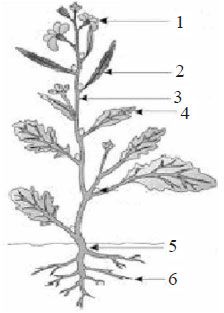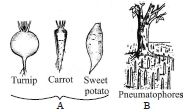Which of the following statement(s) is/are correct about calyx?
Calyx is the outermost whorl of the flower and are called sepals.
Sepals are green, leaf like and protect the flower in the bud stage.
The calyx may be gamosepalous (sepals free) or polysepalous (sepals united).
Both (a) and (b)
Correct Answer :
D. Both (a) and (b)
Calyx or sepals are the outermost lower most non-essential but protective whorl of the flower. Sepals are green, leaf like and protect the flower in bud stage. When the sepals are free from one another, the calyx is said to be polysepalous (mustard) & when the sepals are wholly or partially united with one another by their margins then the calyx is said to be gamosepalous.
Related Questions
A scar on the seed coat through which the developing seeds attached to the fruit is called as ________.
testa
tegmen
hilum
micropyle
Which part of plant is generally green when young and later often become woody and dark brown?
stem
seed
leaves
flower
Which one of the following characteristics does not belong to parietal placentation?
Ovules are borne on central axis.
Ovary is one-chambered but it becomes two-chambered due to the formation of false septum.
Examples are mustard and Argemone.
Both (b) and (c)
Which of the following plants is growing in swampy areas, where many roots come out of the ground and grow vertically upwards?
Potato
Opuntia
Rhizophora
Grass
The given figure shows the parts of flowering plant. Which parts of the given figure were involved in the following functions:
- Storing reserve food material
- Synthesis of plant growth regulators.
- Absorption of water and minerals from the soil.
- Providing a proper anchorage to the plant parts

5 and 6
1, 2 and 6
1, 2, 3 and 4
2, 4, 5 and 6
The main purpose of phyllotaxy for the leaves is to provide sufficient_______.
soil
air
water
light
When a flower has both androecium and gynoecium, it is known as__________.
asexual
bisexual
unisexual
multisexual
The main function(s) of root system is/are
absorption of water and minerals from the soil
storing reserve food material
synthesis of plant growth regulators
All of the above
Which of the following represents the floral characters of liliaceae?
Six tepals, zygomorphic, six stamens, bilocular ovary, axile placentation.
Actinomorphic, polyphyllous, unilocular ovary, axile placentation.
Tricorpellary, actinomorphic, polyandrous, superior ovary, axile placentation.
Bisexual, zygomorphic, gamophyllous, inferior ovary, marginal placentation.
Read the following statements and answer the questions.
- Gynoecium is situated in the centre and other parts of the flower are located on the rim of the thalamus almost at the same level.
- Ovary is half-inferior.
- Examples are plum, rose and peach.
Which condition of flowers is being described by the above statements ?
hypogyny
perigyny
epigyny
none of these
Match column-I with column-II and choose the option which shows their correct combination.
| Column-I | Column-II |
|---|---|
| A. Gamosepalous | I. Flower of lily |
| B. Polysepalous | II. Sterile anther |
| C. Gamopetalous | III. Free petals |
| D. Polypetalous | IV. Free sepals |
| E. Epiphyllous | V. Fused petals |
| F. Staminode | VI. Fused sepals |
A IV, B V, C III, D I, E VI, F II
A IV, B III, C V, D I, E II, F VI
A VI, B IV, C III, D V, E I, F II
A VI, B IV, C V, D III, E II, F I
The part of the root which is most active in water absorption is called
root cap
maturation zone
meristematic zone
zone of elongation
Main function of leaf is
exchange of gases
increase the beauty of a tree
manufacturing of food
nerve impulse induction
Aleurone layer helps in
storage of food in endosperm.
protection of embryo.
utilization of stored food.
all of the above.
Stilt roots occur in __________ .
groundnut
rice
sugarcane
wheat
Which of the following is the green expanded part of leaf with vein and veinlets?
Petiole
Node
Stipule
Lamina
The given figure shows the parts of mango and coconut. Choose the option which shows the correct labelling of A, B, C and D marked in the figures.

A - Epicarp, B - Mesocarp, C - Seed, D - Endocarp
A - Epicarp, B - Mesocarp, C - Ovule, D - Endocarp
A - Epicarp, B - Mesocarp, C - Ovary, D - Endocarp
A - Epicarp, B - Mesocarp, C - Embryo, D - Endocarp
The root differs from stem in having
nodes and internodes
axillary buds
multicellular hairs
unicellular hairs
The given figures (A and B) shows the modificaiton of roots.Which of the following statements regarding the figures is correct ?

Tap roots of carrot, turnip and adventitious root of sweet potato, get swollen and store food.
Pneumatophores conducts water, minerals & photosynthesis
Pneumatophore is found in the plants that grow in sandy soil.
Turnip & carrot shows adventitious roots and sweet potato shows tap root.
Statement-1 : Ginger has a prostrate-growing rhizome.
Statement-2 : Shoot growth is not effected by gravity.
Statement-1 and statement-2 are true and Statement-2 is a correct explanation for statement-1.
Statement-1 and statement-2 are true but statement-2 is a correct explanation for statement-1.
Statement-1 is true and statement-2 is false.
Both the statements are false.
The region of the root-tip which is involved in the formation of root hairs by epidermal cells is called the
region of maturation.
region of meristematic activity.
region of elongation.
none of the above.
Which of the following statement(s) is/are correct about venation?
(i) The arrangement of veins and the veinlets in the lamina of leaf is called venation.
(ii) Reticulate venation is the characteristic of monocots.
(iii) When the veinlets form a network, the venation is termed as reticulate venation.
(iv) When the veins run parallel to each other, within a lamina, the venation is termed as parallel venation.
Only (i)
Both (i) and (ii)
(i), (iii) and (iv)
All of these
Which of the following statement (s) is/are not correct?
- Calyx and corolla are reproductive organs of a flower.
- Zygomorphic flower can be divided into two equal radial halves in any radial plane.
- Flowers without bracts are termed as bracteate.
- Parthenocarpic fruit is formed after fertilization of the ovary.
- In legumes, seed is non-endospermic.
- Radical buds develop on roots.
(i) , (ii), (iii) and (iv)
(i), (ii) and (v)
(iii), (iv) and (vi)
(iv), (v) and (i)
Ginger is an underground stem. It is distinguished from root because
it lacks chlorophyll.
it stores food.
it has nodes and internodes.
it has xylem and vessels.
Which of the following part elongates directly and leads to the formation of primary roots?
bud
radicle
plumule
root hair
Pollen grains are produced within _________of stamen.
ovary
anther
filament
connective
In flower (X), the gynoecium occupies the highest position while the other parts are situated below it. The ovary in such flowers is said to be Y. Identify X and Y and select the correct option.
X - Epigynous, Y - Inferior
X - Perigynous, Y - Superior
X - Hypogynous, Y - Superior
X - Perigynous, Y - Half-inferior
Leaves of dicotyledonous plants possess _________ venation, while _________ venation is the characteristic of most monocotyledons.
reticulate and parallel
parallel and reticulate
reticulate and perpendicular
obliquely and parallel
Floral features are chiefly used in angiosperms identification because
flowers are of various colours.
flowers can be safely pressed.
reproductive parts are more stable and conservative than vegetative parts.
flowers are good materials for identification.
In which of the following plants, a slender lateral branch arises from the base of the main axis and after growing aerially arch downwards to touch the ground?
Mint and jasmine
Banana and pineapple
Grass and stawberry
Pistia and Eichhornia
